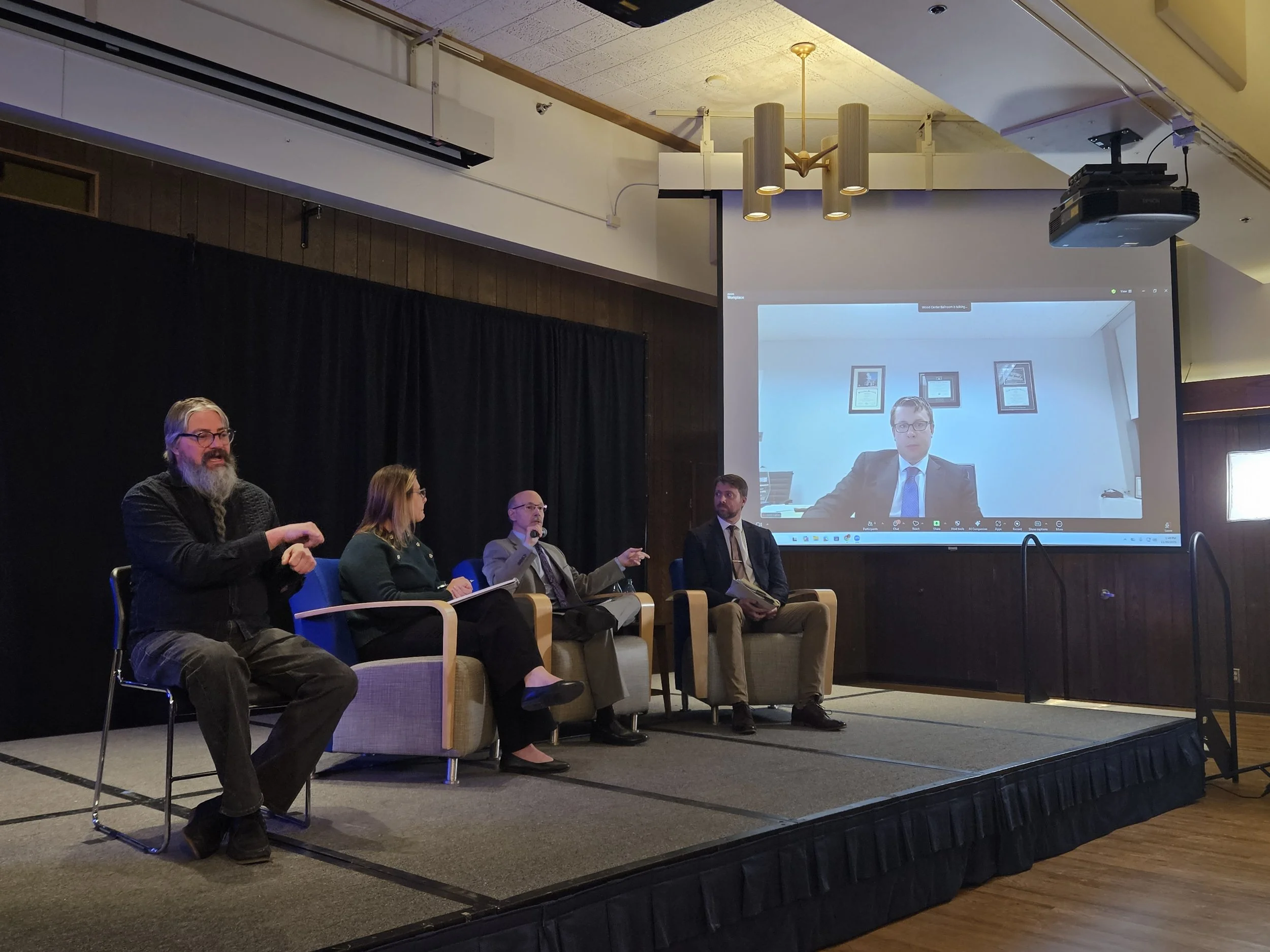Interim Chancellor and team host budget forum
Story and photo by Jonathan Wasilewski
Interpreter Hiatt Rydalch, Vice Chancellor for Administrative Services Julie Queen, Interim Chancellor Mike Sfraga, UA Director of State Relations Chad Hutchison and UA Director of Federal Relations John Latini discuss UAF’s budget.
When Mike Sfraga was appointed interim chancellor at the University of Alaska Fairbanks in July, he knew he had to manage and navigate a dynamic budget landscape. At the chancellor’s budget forum on Nov. 20, his goal was to have the public understand where UAF’s money comes from and how it flows out though the whole community.
The meeting kicked off with Sfraga’s opening remarks and then transitioned to talks from other UA leaders discussing the difficult budget ahead. After Sfraga, Julie Queen, the vice chancellor for administrative services at UAF, spoke to the crowd.
“UAF is the largest of the university budgets in the UA system, and it also has the largest facility footprint with 57 across the state,” she said. UAF’s revenue sources include $174 million from federal funding, $174 million from unrestricted state funding, federal funding in the form of auxiliaries receipts from $98 million, $90 million from intra-agency service centers, $47 million from indirect cost recovery, and $46 million from tuition and fees.
At around $19 million, UAF’s debt is also the largest in the UA system. Yet almost 2,800 donors contributed to UAF last year, raising $9.6 million.
“We wouldn’t be able to achieve all that we have without the continued support of alumni, community employees, employees and donors,” Queen said.
UAF’s total revenues last year were $629 million, up from $580 million in the 2025 fiscal year (or FY25 in budgeting) largely due to increasing state general funds, growing research enterprise, higher tuition revenues and research cost recovery.
Although the amount of state general funds is increasing, it is important to note that they currently make up 28% of UAF’s budget, which is down from 30% last year and 42% in FY15. According to Queen, the university system has to “heavily scale back” relying on these funds.
When state funding isn’t enough, UAF must also reallocate funds internally. Many employees had a 2.75% increase in base pay in July and $7.1 million was given to UAF last year to cover a portion of compensation cost increases from internal reallocating.
Another way UAF receives funding is from over 800 active grants, with the top five agencies funding varying percentages. The National Science Foundation funds 28% of the total portfolio, the Department of Defence funds 16%, the Department of Education funds 10%, the National Aeronautics and Space Administration funds 10%, and the Office of Naval Research funds 5%. The other 31% come from other smaller percentages of sources.
Queen also said she was pleased to see the success of UA’s enrollment strategies, as tuition fees are $47 million instead of $43 million in FY23. Every 1% increase in student enrollment equates to roughly $500,000 of increased revenue for the college. The money can then go to specific academic units.
“UAF is a great deal for Alaskans and out-of-state students alike,” Queen said.
As for the $629 million in expenditures, UAF’s employees make up just under $300 million. Within that amount, $105 million is funded by the grants and contracts that are only allowed to be used for specific purposes.
Next to speak was UA Director of State Relations Chad Hutchison. His talk was focused on the Alaska Legislative Finance Division, which is the natural entity that advises the Alaska legislature. Hutchison predicted that there will be an inflation rate of 2.5% upon a $5 million budget for UAF and other state functions and there is a sum of $524 million for paying off Alaska’s retirement system obligations and dealing with state debt.
Also, other variable factors like the permanent fund and the supplemental budget will determine how much money Alaska is able to give out to its residents. Cost for the recovery from ex-Typhoon Halong was unaccounted for, meaning that the state’s supplemental budget will most likely be much higher this year.
As for the earnings reserve, since Alaska relies on oil sales for funding and its prices are decreasing, it is predicted that overall revenues will be lower than previously projected. Moreover, there was a $552 million deficit in expenses versus revenue in January.
“The thing I think I want to leave with everyone in the university is that we should all be mentally prepared that it’s going to be very, very tight,” Hutchison said.
The final figure to speak was UA Director of Federal Relations John Latini, attending online from Washington D.C.
“This year has been a challenge for universities across the country. There is no doubt,” Latini said. According to Latini, congress has been working on passing bills that reject all the requests in President Trump’s budget to cut funding.
According to Litini, UAF and the UA system have weathered the fiscal storm extremely well. At UAF, there have been only one frozen grant and three delayed grants totaling just $17 million.
“That's less than half a percent of our active awards and only 3% of our active award amounts,” he said.
At the whole of UA, there have been 29 grants terminated this year that total $7.9 million. “I think we are in a much better place than other institutions,” Litini said.
However, the termination of the Alaska Native and Native Hawaiian Serving Program are not reflected in these numbers because the university hasn’t given up restoring those funds.
“Getting that program addressed is a top priority of mine right now,” he said.
Litini closed out his talk with some good news: There have been 23 grants unfrozen with a total value of $68.8 million.
At the very end of the forum, there was time for a few short questions.
The Sun Star asked how the new Indigenous studies building would be funded as federal funding remains uncertain. Provost and Executive Vice Chancellor Charlene Stern answered.
“A lot of our core Indigenous programming is actually funded by other sources through Fund One and other things,” she said. She explained that the Troth Yeddah’ Indigenous Studies Center will be privately funded and they are currently fundraising.
At the end of her speaking portion, Queen had some positive words to say.
“There's a team of amazing people behind this level of management, and I want to thank you and your leadership for all of the hard work to manage our budgets at all levels.”


